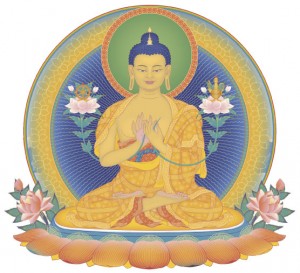The Four Seals of the Dharma
As described in The
Dharma Jewel, there are many different schools of Buddhism, which provide different
presentations of the Buddha's teaching. Different schools appeal to different
personalities, and no one school claims to be 'right'.
So what is it that all forms of Buddhism have in common, and what differentiates
Buddhism from other religions and philosophies?
The defining features of Buddhism are THE FOUR SEALS OF THE DHARMA -
four statements about the world which form the basis of all Buddhist
teachings. The four seals aren't 'revealed truths' which we have to take on
trust from some self-proclaimed 'prophet' who claims to have heard the voice of God, they
are philosophical statements derived from logic and experience. They are:
(1) Impermanence. All phenomena are subject to change, growth, dissolution and
decay. Even the sun, planets and galaxies are changing and will one day cease to
exist.
(2) All phenomena are unfindable upon analysis.
If you search for the ultimate nature of your car, you won't find it. All you'll find is
parts, the causes of those parts coming together, and mental projection or 'imputation' of
something that performs the function of a car. Similarly with the ego - the self.
The essential nature of the self is as unfindable as the essential nature of a car or Milinda's chariot. 'We are
such stuff as dreams are made on'.
(3) Materialistic existence is ultimately unsatisfactory.
All emotions based on the three mental
poisons of attachment, aversion and ignorance are ultimately painful. You can never
have enough worldly possessions, and even if you did you'd worry about losing them since
they are all impermanent. And you've got to lose the lot eventually when you shuffle
off your coil. All materialistic cravings eventually lead to dissappointment and
worse. This is known as dukkha.
(4) The true nature of mind is clarity and peace, 'but
whilst this muddy vesture of decay doth grossly close it in' we cannot experience it. The
sky-like clarity of the mind is obscured by the thunder clouds of anger, attachment and
ignorance. The real nature of the mind is Nirvana - which is NOT
nothingness, but the non-conceptual peace 'which passeth all understanding'.
|
